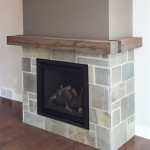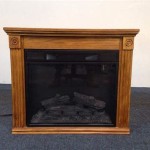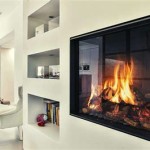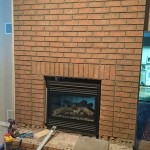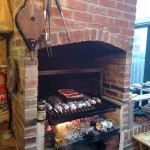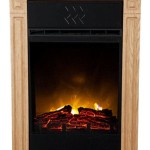The Allure and Practicality of a Fireplace on an Interior Wall
A fireplace situated on an interior wall presents a unique and compelling design choice for homeowners. Moving beyond the traditional placement against an exterior wall, this configuration offers significant advantages in terms of spatial arrangement, aesthetic impact, and overall functionality. The strategic placement of a fireplace on an interior wall can redefine room layouts, create focal points, and contribute to the heating efficiency of a living space.
The decision to install a fireplace on an interior wall requires careful consideration of several factors, including the type of fireplace, the structural integrity of the wall, venting requirements, and the overall design scheme. Proper planning and professional installation are crucial to ensure safety, efficiency, and a visually appealing outcome. Ignoring these factors can lead to structural problems, heat inefficiency, and potentially hazardous situations.
This article explores the various aspects of incorporating a fireplace into an interior wall, examining the benefits, considerations, and design possibilities associated with this increasingly popular architectural trend. This information is intended to provide a comprehensive overview of the topic, equipping homeowners and designers with the necessary knowledge to make informed decisions.
Enhanced Spatial Arrangement and Room Definition
One of the primary benefits of placing a fireplace on an interior wall is the opportunity to redefine the layout of a room. Unlike traditional fireplaces, which are often relegated to exterior walls, an interior fireplace can serve as a natural room divider, creating distinct zones within a larger space. This is particularly advantageous in open-concept homes, where a fireplace can delineate living areas from dining areas or kitchen spaces.
By strategically positioning a fireplace on an interior wall, architects and designers can create a more functional and aesthetically pleasing flow within the home. The fireplace itself becomes a focal point, drawing the eye and establishing a center of gravity for the surrounding furniture arrangement. This can lead to more inviting and comfortable living spaces, promoting social interaction and a sense of warmth.
Furthermore, an interior fireplace can be used to create a sense of intimacy within a large room. By dividing the space into smaller, more defined areas, the fireplace helps to mitigate the feeling of being overwhelmed by the size of the room. This can be particularly beneficial in homes with high ceilings or expansive floor plans. The placement of furniture around the fireplace creates a natural gathering spot, encouraging conversation and relaxation.
The flexibility offered by an interior fireplace is also a significant advantage. Unlike exterior fireplaces, which are constrained by structural limitations and venting requirements, interior fireplaces can be positioned in a wider range of locations. This allows for greater customization and the ability to adapt the fireplace to the specific needs and preferences of the homeowner. For instance, a double-sided fireplace can be installed on an interior wall to provide warmth and ambiance to two adjacent rooms simultaneously. This feature enhances both the functionality and aesthetic appeal of the living space.
Creating a Dramatic Focal Point
A fireplace inherently draws attention, serving as a natural focal point in any room. Placing it on an interior wall amplifies this effect, allowing the fireplace to become a central design element that dictates the character of the space. The architectural impact is magnified, particularly when the fireplace design is carefully considered to complement the surrounding décor.
The design possibilities are extensive when considering an interior wall fireplace. Options range from sleek, modern gas fireplaces with minimalist surrounds to rustic, traditional wood-burning fireplaces with exposed brick or stone. The choice of materials, textures, and colors can be tailored to reflect the homeowner's personal style and the overall aesthetic of the room. A well-designed fireplace can instantly elevate the visual appeal of a space, transforming it from ordinary to extraordinary.
Beyond the fireplace itself, the surrounding wall can also be used to create a dramatic visual statement. Built-in shelving units, custom cabinetry, or artwork can be incorporated to enhance the fireplace's presence and create a cohesive design. The wall can be painted a contrasting color to further accentuate the fireplace, or it can be clad in a unique material, such as wood paneling or textured wallpaper. The goal is to create a visually compelling feature that draws the eye and adds depth and interest to the room.
Lighting also plays a crucial role in highlighting an interior wall fireplace. Strategically placed spotlights or sconces can accentuate the texture and detail of the fireplace surround, creating a warm and inviting ambiance. Recessed lighting can be used to softly illuminate the surrounding wall, adding depth and dimension to the space. The careful use of lighting can transform the fireplace into a stunning visual centerpiece, enhancing its impact and creating a focal point that is both functional and aesthetically pleasing.
Furthermore, the absence of natural light sometimes associated with interior walls can be leveraged to create a more dramatic and intimate atmosphere. The flickering flames of the fireplace become even more captivating in a dimly lit space, creating a cozy and inviting ambiance. This is particularly appealing in bedrooms or home theaters, where a fireplace can add a touch of luxury and create a relaxing environment.
Optimized Heating Efficiency and Distribution
While aesthetic considerations are paramount, the placement of a fireplace on an interior wall can also contribute to improved heating efficiency. By locating the fireplace in the center of the home, rather than against an exterior wall, the heat generated by the fireplace is more evenly distributed throughout the living space. This can lead to a more comfortable and energy-efficient heating solution, particularly in colder climates.
Traditional fireplaces located on exterior walls often suffer from heat loss due to poor insulation and drafts. The heat generated by the fireplace is quickly dissipated through the exterior wall, resulting in a less efficient heating system. An interior fireplace, on the other hand, benefits from the thermal mass of the surrounding walls, which helps to retain heat and radiate it back into the room. This can significantly reduce heat loss and improve the overall efficiency of the fireplace.
Additionally, the central location of an interior fireplace allows for better air circulation. The heat rises and circulates throughout the room, providing warmth to all areas of the space. This is particularly beneficial in open-concept homes, where the heat can easily flow from one area to another. The fireplace can also be used in conjunction with a forced-air heating system to supplement the existing heating and create a more comfortable and consistent temperature throughout the home.
Modern fireplace technologies, such as direct-vent gas fireplaces and electric fireplaces, further enhance the heating efficiency of interior fireplaces. Direct-vent gas fireplaces draw combustion air from outside and vent exhaust gases directly outside, minimizing heat loss and improving air quality. Electric fireplaces are highly efficient and require no venting, making them a convenient and cost-effective heating solution for interior spaces. These technologies allow homeowners to enjoy the warmth and ambiance of a fireplace without sacrificing energy efficiency.
The positioning of the fireplace relative to the home's insulation is also a critical factor. Interior walls are generally better insulated than exterior walls, further enhancing the fireplace's heating efficiency. This is particularly important in older homes, where the insulation may be inadequate. By placing the fireplace on an interior wall, homeowners can mitigate the impact of poor insulation and improve the overall heating performance of the home.
Finally, consider the size and BTU (British Thermal Unit) output of the fireplace when planning an interior wall installation. A fireplace that is too small will not provide sufficient heat for the space, while a fireplace that is too large may overheat the room and waste energy. Consulting with a qualified fireplace professional is essential to determine the appropriate size and BTU output for the specific needs of the home.

7 Fireplace Surround Ideas That Will Ignite The Room

Recessed Or Wall Mount Electric Fireplace Installations Explained Touchstone Home S Inc

21 Fireplace Upgrades For Any Room Small Living Decor Feature Wall

How To Create The Perfect Media Wall With A Fireplace Direct Fireplaces

Can You Install A Gas Fireplace On Interior Wall Just Log Fires

Design Dilemmas How To A Great Room Fireplace Wall With Built Ins And Television Interior Designer Des Moines Jillian Lare

ᑕ❶ᑐ Electric Fireplace In A Wall What Should You Know

Real Flame 65 In Wall Mount Recessed Electric Fireplace Insert Black 5560 The Home Depot

5 Ways A Fireplace Can Benefit Your Interior Design Fiveways Fires Stoves

Natural Stacked Stone Veneer Fireplace Ideas
Related Posts

